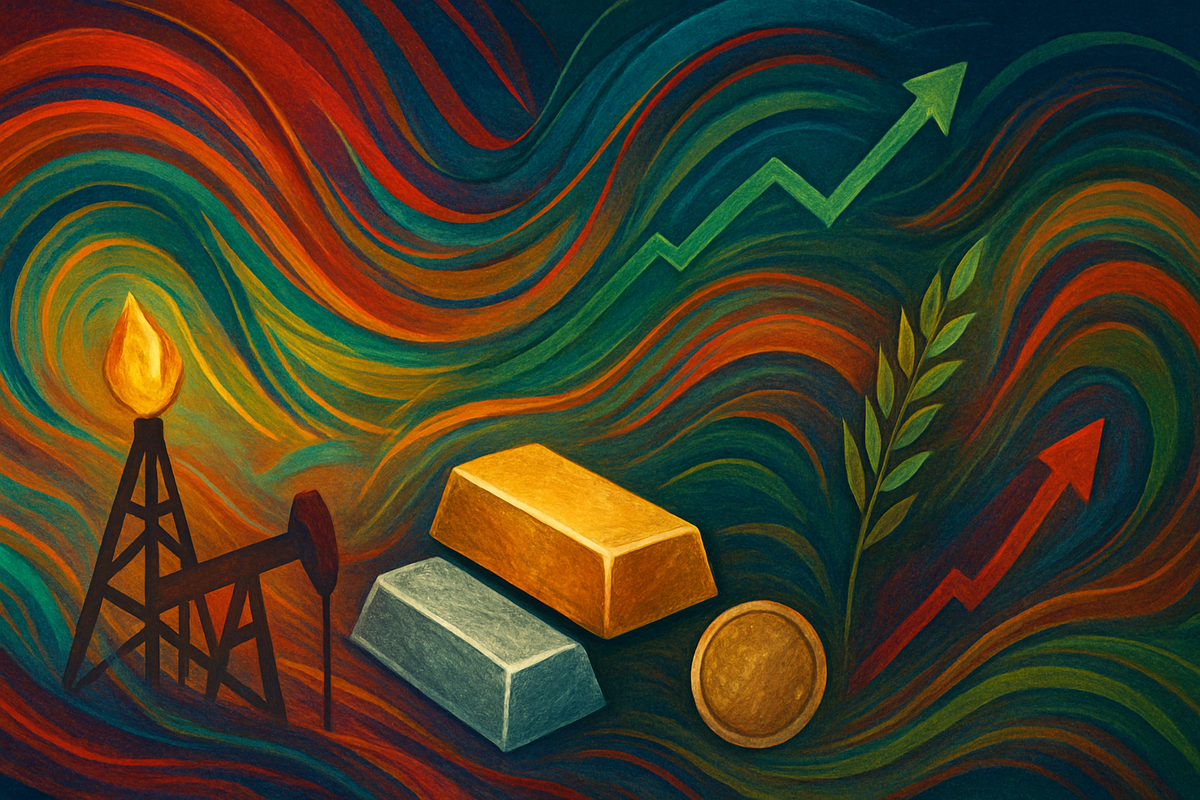
As of November 14, 2025, global commodity markets are in the throes of significant volatility, presenting a complex mosaic of risks and unparalleled opportunities for astute investors. A confluence of persistent geopolitical tensions, a looming global economic slowdown, and the accelerating imperatives of the energy transition are creating divergent price movements across key raw materials. While a general softening of overall commodity prices is anticipated through 2026, driven by a projected deceleration in global economic growth, specific sectors such as precious metals and natural gas are exhibiting remarkable strength, drawing considerable investor attention and reshaping industrial landscapes worldwide.
This dynamic environment necessitates a granular understanding of market forces, as distinct drivers are influencing different commodity classes. From the robust rally in industrial metals fueled by decarbonization efforts to the safe-haven allure of gold and silver amidst economic uncertainty, and the localized surges in natural gas due to weather and export demand, the commodity sector is far from monolithic. For market participants, discerning these intricate patterns and their underlying catalysts is paramount to navigating the current tempest and positioning for potential gains or mitigating significant losses.
The Shifting Sands: Detailed Coverage of Commodity Market Dynamics
The current volatility in commodity markets, as witnessed on November 14, 2025, is a multifaceted phenomenon, deeply rooted in a series of interconnected global events and structural shifts. Geopolitical instability, including ongoing conflicts and trade disputes, continues to cast a long shadow, particularly over energy supplies. Simultaneously, major central banks, including the U.S. Federal Reserve, are contemplating monetary policy shifts, with anticipated interest rate cuts influencing currency valuations and the appeal of inflation-hedging assets. Persistent inflation concerns in major economies further bolster the case for commodities as a store of value.
The timeline of events leading to this moment reveals a complex interplay of factors. Throughout 2025, the global economy has grappled with the dual pressures of inflationary remnants and a decelerating growth trajectory. Supply chain disruptions, a lingering legacy of recent global events, continue to exert upward pressure on certain raw materials. Crucially, the accelerating global energy transition is fundamentally reshaping demand patterns, creating unprecedented appetites for critical minerals essential for green technologies. Weather patterns, from cold spells impacting natural gas demand to drought conditions affecting agricultural yields, add another layer of unpredictable volatility. Key players and stakeholders in this environment include OPEC+, whose production decisions heavily sway oil markets; major mining companies influencing metal supplies; central banks dictating monetary policy; and large institutional investors whose capital flows amplify market movements.
Initial market reactions have been characterized by a flight to quality and strategic re-allocations. Precious metals, particularly gold and silver, have seen significant inflows as investors seek refuge from uncertainty. Industrial metals, especially copper, have experienced an extraordinary rally, driven by the structural demand from electrification and renewable energy projects. In contrast, crude oil has seen moderate fluctuations, with an anticipated oversupplied market tempering significant upward movement despite recent recoveries. Natural gas, however, has surged due to robust export demand and cold weather forecasts, impacting energy costs globally. Agricultural commodities present a mixed picture, with some grains showing cautious gains ahead of supply reports, while others like wheat remain subdued due to ample global supplies.
Winners and Losers: Corporate Fortunes in a Volatile Market
The turbulent commodity landscape is creating a clear divide between companies poised to capitalize on rising prices and those facing increased operational costs and margin compression. On the winning side, energy producers stand to benefit from the sustained strength in natural gas prices. Companies like EOG Resources (NYSE: EOG) and Cheniere Energy (NYSEAMERICAN: LNG), a major U.S. liquefied natural gas exporter, are well-positioned to leverage robust export demand and higher domestic prices. The latter, in particular, is directly benefiting from record U.S. LNG exports and strong European and Asian demand.
In the metals sector, mining companies focused on copper, gold, and silver are experiencing a significant uplift. Freeport-McMoRan (NYSE: FCX), a leading copper producer, is a prime beneficiary of copper's extraordinary rally, driven by energy transition demand and supply disruptions. Its margins are likely expanding due to higher prices and potential U.S. tariffs on imports. Similarly, gold miners such as Barrick Gold (NYSE: GOLD) and Newmont Corporation (NYSE: NEM) are seeing increased profitability as gold prices hover near record highs, potentially coupled with lower energy input costs. Silver miners, given silver's dual role as an industrial and precious metal, are also poised for substantial gains.
Conversely, manufacturing companies, airlines, and food processors are among those facing significant headwinds. Industries reliant on copper, such as General Electric (NYSE: GE) or Tesla (NASDAQ: TSLA) for its EV production, will contend with higher input costs, potentially impacting their profitability and the cost of their end products. Airlines, despite a softening in crude oil prices, still face overall elevated energy costs, particularly if jet fuel prices remain sticky. Companies in the food sector, like Kraft Heinz (NASDAQ: KHC), could see increased raw material costs if agricultural commodity prices, particularly for grains like corn and soybeans, continue to rise, potentially leading to higher consumer prices or reduced margins. The rising cost of natural gas, a critical industrial fuel, is also impacting a wide array of manufacturers, leading to increased operational expenses across the board.
Broader Implications: Reshaping Industries and Policy
The current volatility in commodity markets is not merely a short-term blip; it represents a profound reshaping of broader industry trends and economic paradigms. At its core, this event underscores the accelerating global energy transition. The shift from a fuel-intensive to a material-intensive energy system is driving unprecedented demand for critical minerals like copper, silver, and lithium. This structural demand ensures that price sensitivity in these metals will have long-term implications for the pace and cost of decarbonization efforts worldwide, affecting everything from electric vehicle production to renewable energy infrastructure deployment.
The ripple effects extend across industries. Competitors in manufacturing sectors are grappling with varying abilities to absorb or pass on increased raw material costs, potentially leading to shifts in market share. Partners in supply chains are re-evaluating sourcing strategies and geographical dependencies to mitigate risks associated with price swings and supply disruptions. Regulatory and policy implications are also significant. The U.S. imposition of a 50% tariff on copper imports, effective August 1, 2025, is a clear example of policy intervention aimed at securing domestic supply and potentially boosting domestic production, but it also signals a move towards resource nationalism that could fragment global markets further. Central bank monetary policies, particularly interest rate decisions, continue to exert a powerful influence on commodity prices by affecting the U.S. dollar's strength and the attractiveness of alternative investments.
Historically, periods of significant commodity volatility have often coincided with major geopolitical realignments or economic shocks. Comparisons can be drawn to the oil shocks of the 1970s, which triggered widespread inflation and economic restructuring, or the commodity supercycle of the early 2000s driven by rapid industrialization in emerging economies. While the current scenario is unique due to the overlay of the energy transition, these historical precedents highlight the potential for sustained inflationary pressures and significant wealth transfers between commodity-producing and consuming nations. The ongoing shifts suggest a more fragmented and strategically critical approach to raw material security will become a hallmark of international economic policy.
What Comes Next: Navigating the Future Landscape
Looking ahead, the commodity markets are poised for continued dynamism, with both short-term and long-term possibilities demanding strategic foresight from investors and corporations alike. In the short term, the trajectory of geopolitical events and central bank monetary policy decisions will heavily influence price movements. Any escalation in global tensions could provide further impetus for safe-haven assets and disrupt energy supplies. Conversely, clear signals of a global economic slowdown could temper demand for industrial commodities. Natural gas prices are likely to remain sensitive to winter weather patterns and the pace of U.S. LNG export growth.
Longer term, the structural demand driven by the energy transition will likely continue to underpin strong prices for critical minerals. This suggests that while overall commodity indices might soften, a divergence will persist, with "green metals" maintaining their premium. Companies will need to consider strategic pivots, focusing on supply chain resilience, hedging strategies, and potentially investing in upstream production or recycling technologies to secure critical inputs. Market opportunities may emerge in companies innovating in resource efficiency, sustainable sourcing, and those developing advanced materials that can reduce reliance on volatile commodities. Challenges include managing the capital expenditure required for new mining projects and navigating increasingly complex regulatory environments. Potential scenarios range from a gradual normalization of supply chains and a soft landing for the global economy, leading to a more stable but still high-priced commodity environment, to continued geopolitical fragmentation and persistent inflationary pressures, which would further entrench the current volatility.
Comprehensive Wrap-Up: Key Takeaways and Future Watchpoints
In summary, the commodity markets as of November 14, 2025, are defined by pronounced volatility, driven by a powerful confluence of geopolitical risks, a global economic slowdown, and the transformative demands of the energy transition. Key takeaways include the diverging fortunes of different commodity classes—with precious and industrial metals largely outperforming, natural gas experiencing significant surges, and crude oil and agriculture showing more mixed trends. This environment underscores the critical need for a nuanced, sector-specific investment approach rather than broad market assumptions.
Moving forward, the market will likely remain characterized by this divergence, with the "material-intensive" nature of the energy transition providing structural support for critical minerals while traditional energy and agricultural commodities respond more acutely to macroeconomic and weather-related factors. Investors should assess their portfolios for adequate diversification, with particular attention to assets that act as inflation hedges or directly benefit from the decarbonization megatrend. The potential for U.S. interest rate cuts in 2026 could further bolster the appeal of non-yielding assets like gold.
What investors should watch for in the coming months includes the evolution of geopolitical conflicts, central bank communications regarding interest rate policy, the pace of global economic growth (particularly in China), and any new policy interventions related to critical mineral supply chains. The performance of key public companies such as Freeport-McMoRan (NYSE: FCX), Cheniere Energy (NYSEAMERICAN: LNG), and major gold miners will serve as bellwethers for specific segments of the commodity market. Furthermore, monitoring advancements in sustainable technologies and resource efficiency will be crucial for identifying long-term winners in this evolving landscape.
This content is intended for informational purposes only and is not financial advice





